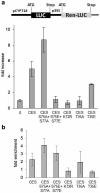Interplay between phosphorylation and SUMOylation events determines CESTA protein fate in brassinosteroid signalling
- PMID: 25134617
- PMCID: PMC4167607
- DOI: 10.1038/ncomms5687
Interplay between phosphorylation and SUMOylation events determines CESTA protein fate in brassinosteroid signalling
Abstract
Brassinosteroids (BRs) are steroid hormones that are essential for plant growth. Responses to these hormones are mediated by transcription factors of the bri1-EMS suppressor 1/brassinazole resistant 1 subfamily, and BRs activate these factors by impairing their inhibitory phosphorylation by GSK3/shaggy-like kinases. Here we show that BRs induce nuclear compartmentalization of CESTA (CES), a basic helix-loop-helix transcription factor that regulates BR responses, and reveal that this process is regulated by CES SUMOylation. We demonstrate that CES contains an extended SUMOylation motif, and that SUMOylation of this motif is antagonized by phosphorylation to control CES subnuclear localization. Moreover, we provide evidence that phosphorylation regulates CES transcriptional activity and protein turnover by the proteasome. A coordinated modification model is proposed in which, in a BR-deficient situation, CES is phosphorylated to activate target gene transcription and enable further posttranslational modification that controls CES protein stability and nuclear dynamics.
Figures





Similar articles
-
MYBL2 is a substrate of GSK3-like kinase BIN2 and acts as a corepressor of BES1 in brassinosteroid signaling pathway in Arabidopsis.Proc Natl Acad Sci U S A. 2012 Dec 4;109(49):20142-7. doi: 10.1073/pnas.1205232109. Epub 2012 Nov 19. Proc Natl Acad Sci U S A. 2012. PMID: 23169658 Free PMC article.
-
Brassinosteroid-regulated bHLH transcription factor CESTA induces the gibberellin 2-oxidase GA2ox7.Plant Physiol. 2022 Mar 28;188(4):2012-2025. doi: 10.1093/plphys/kiac008. Plant Physiol. 2022. PMID: 35148416 Free PMC article.
-
Transcription factor HAT1 is phosphorylated by BIN2 kinase and mediates brassinosteroid repressed gene expression in Arabidopsis.Plant J. 2014 Jan;77(1):59-70. doi: 10.1111/tpj.12368. Epub 2013 Dec 3. Plant J. 2014. PMID: 24164091
-
Post-translational Regulation of BRI1-EMS Suppressor 1 and Brassinazole-Resistant 1.Plant Cell Physiol. 2024 Nov 13;65(10):1544-1551. doi: 10.1093/pcp/pcae066. Plant Cell Physiol. 2024. PMID: 38896040 Review.
-
Brassinosteroid signaling in plant development and adaptation to stress.Development. 2019 Mar 14;146(5):dev151894. doi: 10.1242/dev.151894. Development. 2019. PMID: 30872266 Free PMC article. Review.
Cited by
-
TRANSTHYRETIN-LIKE and BYPASS1-LIKE co-regulate growth and cold tolerance in Arabidopsis.BMC Plant Biol. 2020 Jul 14;20(1):332. doi: 10.1186/s12870-020-02534-w. BMC Plant Biol. 2020. PMID: 32664862 Free PMC article.
-
The Hydrogen-Coupled Oligopeptide Membrane Cotransporter Pept2 is SUMOylated in Kidney Distal Convoluted Tubule Cells.Front Mol Biosci. 2021 Nov 22;8:790606. doi: 10.3389/fmolb.2021.790606. eCollection 2021. Front Mol Biosci. 2021. PMID: 34881291 Free PMC article.
-
Brassinosteroids participate in the control of basal and acquired freezing tolerance of plants.Proc Natl Acad Sci U S A. 2016 Oct 4;113(40):E5982-E5991. doi: 10.1073/pnas.1611477113. Epub 2016 Sep 21. Proc Natl Acad Sci U S A. 2016. PMID: 27655893 Free PMC article.
-
Protein sumoylation and phosphorylation intersect in Arabidopsis signaling.Plant J. 2017 Aug;91(3):505-517. doi: 10.1111/tpj.13575. Epub 2017 Jun 4. Plant J. 2017. PMID: 28419593 Free PMC article.
-
Reprogramming of cardiac phosphoproteome, proteome, and transcriptome confers resilience to chronic adenylyl cyclase-driven stress.Elife. 2024 Jan 22;12:RP88732. doi: 10.7554/eLife.88732. Elife. 2024. PMID: 38251682 Free PMC article.
References
-
- Fujioka S, Yokota T. Biosynthesis and metabolism of brassinosteroids. Annu Rev Plant Biol. 2003;54:137–164. - PubMed
-
- Kinoshita T, et al. Binding of brassinosteroids to the extracellular domain of plant receptor kinase BRI1. Nature. 2005;433:167–171. - PubMed
-
- Guo H, Li L, Aluru M, Aluru S, Yin Y. Mechanisms and networks for brassinosteroid regulated gene expression. Curr Opin Plant Biol. 2013;16:545–553. - PubMed
-
- Kim TW, Wang ZY. Brassinosteroid signal transduction from receptor kinases to transcription factors. Annu Rev Plant Biol. 2010;61:681–704. - PubMed
Publication types
MeSH terms
Substances
Grants and funding
LinkOut - more resources
Full Text Sources
Other Literature Sources
Molecular Biology Databases

